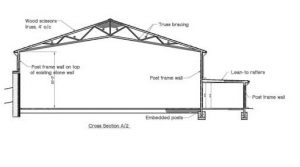“Since the peaked end of my new post frame building will be so much higher than the sidewalls, how about I place a very tall overhead door at the center of it?”
Today’s topic was prompted by BILL from BUFFALO who writes: “Have you ever attempted to install an overhead door in an end wall (gable roof) that is higher than the eaves? Client wants a door high enough for his RV but doesn’t want the added eave height where he tying into his house.”
In general the challenge is the overhead door will fit in the endwall. However, when driving something very tall through the door, the roof trusses make a nasty slapping sound when the bottom chords are breaking, just before they collapse on whatever hit them.
There ARE some alternatives to those nasty noises.
Please read on……
 The most common approach to this design problem is to change the roof trusses from a standard gabled truss, to a scissors truss. With standard trusses, the bottom chord (lowest horizontal framing member) extends from sidewall to sidewall and reduces the interior clear height of your post frame building by six inches or more.
The most common approach to this design problem is to change the roof trusses from a standard gabled truss, to a scissors truss. With standard trusses, the bottom chord (lowest horizontal framing member) extends from sidewall to sidewall and reduces the interior clear height of your post frame building by six inches or more.
I’ve expounded at length on the use of scissor trusses for this very application here: https://www.hansenpolebuildings.com/2016/10/scissors-trusses-post-frame-buildings/
In order to gain the absolute greatest possible door height, adding interior columns and using rafters as opposed to prefabricated metal plate connected roof trusses makes for a great solution.
Here is an example of how this can work:
Imagine, if you will, a 36 foot wide building with a 10 foot eave height and a 4/12 roof slope. Let’s say you want to have a 12 foot wide by 12 foot tall overhead door in the center of the endwall. Lots of wall there, so let’s make use of it!
By strategically placing interior columns at 11 feet from each sidewall, and cantilevering rafters tied into the sidewall columns and over these new interior columns, more than enough clearance is added to successfully make this challenge into a reality. The overhead door tracks will just fit on the inside of the interior column and the added height from the rafters going upwards with the slope of the roof makes for an efficient design solution (albeit perhaps a little odd looking exterior appearance).






